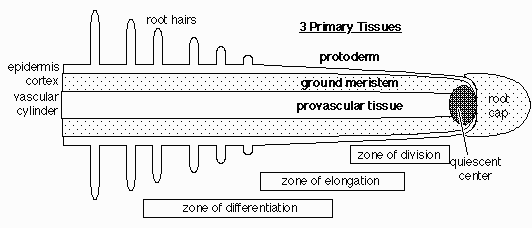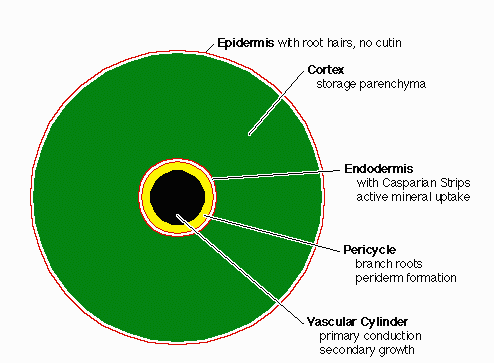| Admissions | Accreditation | Booksellers | Catalog | Colleges | Contact Us | Continents/States/Districts | Contracts | Examinations | Forms | Grants | Hostels | Honorary Doctorate degree | Instructors | Lecture | Librarians | Membership | Professional Examinations | Programs | Recommendations | Research Grants | Researchers | Students login | Schools | Search | Seminar | Study Center/Centre | Thesis | Universities | Work counseling |
|
Angiosperm Anatomy
There are between 200 000 and 300 000 different species of angiosperms (flowering plants) known. In comparison with other organisms, only insects number more species than angiosperms. Although a wide variety of flowering plants occur on earth, all have more or less the same structure and consist of three basic organs: roots, stems and leaves. Angiosperms are divided, according to certain characteristics which you studied in std.7, into two large groups, viz. Dicotyledoneae and Monocotyledoneae. In this section I shall refer to the former group as dicotyledons and the latter group as monocotyledons. In this chapter you will learn more about the anatomy of : | roots | stems | leaves | flowers | Roots The root system of a flowering plant begins its development from the hypocotyl of the embryo of the seed which gives rise to the primary root. Roots generally grow downwards into the soil (positively geotropic) and upwards (negatively geotropic). Roots do not bear leaves and therefore no nodes are present.Two kinds of root systems can be distinguished in flowering plants: tap root systems and adventitious root systems. Usually dicotyledons posses tap root systems and monocotyledons adventitious root systems. * Tap Root System: The primary root grows vertically down into the soil in the tap root system. Later lateral or secondary roots grow from this at an acute angle outwards and downwards, and from these other branches may arise. The main or primary root is known as the tap root; together with its many branch roots it forms a tap root system e.g. the bean. * Adventitious Root System: The primary root usually dies at an early stage and is replaced by numerous roots that develop from the stem. These roots, which develop from the stem, are equal in size. They are known as a adventitious roots, which give rise to branch or lateral roots and form an adventitious root system, e.g. the mealie. Functions of the Root * Roots anchor the plant in the soil. * Roots absorb water and mineral salts from the soil. * Roots may store food. * Roots form a passage way for water and dissolved substances from the root into the stem and also for foods from the stem down into the root. Root of a Dicotyledonous Plant: External Features If we study the root tip of a flower plant under a dissecting microscope or with a hand lens, the following regions can be distinguished: The Root Cap The tip of the root is covered by a cap that is shaped like a thimble. The outer cells of the root cap are continuously being worn away and new cells are added to the inner portion. As these cells disintegrate they form a strong protective cover. Function * The root cap covers and protects the delicate growing tip from injury and damage as the root pushes its way through the soil. The Meristematic Region or Growing Point This region occurs immediately behind the root cap. The Meristematic region consists of meristematic tissue and is protected by the root cap. The cells are very active and divide rapidly to form new cells which differentiate later to form more specialized root tissues. The cells of this region also replace the cells rubbed-off from the root cap and provide additional cells for the next region. Function * This is the region where the cells divide and where additional cells are provided for the zone of elongation. The Region of Elongation The cells formed in the meristematic region undergo rapid growth in length. This causes the root to elongate and penetrate deeper into the soil in search for water and mineral salts. The meristematic and elongation zones are also referred to as the region of growth. Function * In this region the cells undergo rapid enlargement,i.e. the cells undergo rapid growth in length. The Root-hair Region The root hair region occurs a short distance above the region of elongation. Here a large number of fine, hair-like outgrowths are formed. The root hairs arise from the epidermal tissue of the root and are called root hairs. The root hairs are short and short-lived and develop on the primary and secondary roots. A root-hair consists of the following parts: a thin cell wall, a thin lining of cytoplasm which contains the nucleus and a comparatively large vacuole containing cell sap. Function * The main function of the root hairs is to increase the area of absorption of the root. The Mature Region The mature region is situated above the root hair region. Here the root becomes thicker and secondary or lateral roots are developed. The secondary roots in turn rebranch to form tertiary roots. Each lateral branch has its own cap, root hairs, meristematic, elongation and mature regions. The roots in this region are covered by a protective cork layer . Functions * In this region the cells undergo differentiation into specialized cells,(e.g. xylem and phloem). * It also serves to anchor the plant.  A diagrammatic representation of a tap root its tissue systems. Root of a Dicotyledonous Plant: Internal Features When we study microscopically, a transverse section through the root hair region of a young dicotyledonous root, we are able to identify the following tissues from the outside to the inside: Epidermis The epidermis is the outer layer of the cells of the young root. The cells are closely- packed, thin-walled parenchyma cells with no cuticle, chloroplasts or stomata. Root hairs arise from some of the epidermal cells. Functions * The epidermis protects the underlying tissues of the root. * The epidermal cells and the root hairs absorb water and dissolved ions. Cortex On the inner side of the epidermis is the cortex and in many plant types it can be subdivided into an exodermis, a central cortex and endodermis. The cell walls are thickened and contain suberin and lignin. The central cortex usually consists of thin-walled parenchyma cells with numerous intercellular spaces . The endodermis forms the innermost layer of the cortex.These cells are more rectangular in shape, the side walls being thickened with suberin. These thickenings are called casparian strips. Functions * The cortex allows for the diffusion of water, mineral salts and oxygen from the root hairs inwards. * The cortex stores foods reserve, especially starch. * The cortex also serves to transport water and salts from the root hairs to the center of the root. * The endodermis, with the aid of the Casparian strips, facilitates the movement of water from cortex to xylem. Vascular Cylinder or Stele The vascular cylinder comprises all the tissues enclosed by the endodermis. It consists of the pericycle and vascular tissues(xylem and phloem). The pericycle is a single layer of thick-walled, tightly-packed cells without intercellular spaces. Lateral roots arise from the pericycle. The vascular tissue is conducting tissue in the root. It consists of xylem and phloem, which are separated from each other by parenchyma. Only primary xylem is present in young roots, which differentiated into protoxylem, which lies against the pericycle, and the metaxylem lying towards the inside. The primary xylem consists of non-living, thick- walled xylem vessels and tracheids. The phloem alternates between the arms of the xylem and consists of living thin-walled cells (sieve tubes, companion cells, and phloem parenchyma). Functions * Branch or lateral roots originate in the pericycle. * The xylem transports water and dissolved substances from the roots to the stem and leaves. * The xylem is the main strengthening tissue of the root. * The phloem transports organic substances such as carbohydrates from the leaves to the root.  A diagrammatic representation of a dicot stem with the different tissue systems of the stem. Secondary Thickening in Dicotyledonous Stems In herbaceous dicots a limited amount of secondary thickening occurs, while it is more evident in perennial, woody dicots. The stem increases in thickness as it grows older. In the vascular bundle of a young dicot stem the xylem and phloem are separated by cambium. Secondary thickening begins when mature parenchyma cells in the medullary rays which lie between the adjacent vascular bundles become meristematic and form the fascicular cambium. The fascicular cambium forms a continuous ring of cambium as it joins up with the fascicular cambium. This cambium ring undergoes division to form secondary phloem to the outside and secondary xylem to the inside. The secondary xylem and secondary phloem are laid down in the form of concentric cylinders on either side of the cambium ring. At certain points the cambium forms parenchyma, which radiates from the middle of the stem through the secondary xylem and secondary phloem to form vascular rays. As a result of these changes the stem increases in thickness. The primary xylem and phloem are pushed further and further apart. The pith remains alive. Some of the parenchyma cells between the vascular bundles continue to exist to form radially directed vascular rays. Annual rings develop in the secondary xylem, each consisting of a layer of spring wood and a layer of autumn wood. A cylindrical meristem develops in the cortex, the cork cambium (phellogen). The cork cambium gives rise to the cork cells (phellem) on the outside and the secondary cortex (phelloderm) on the inside. Together this is known as the periderm. Opposite the stomata the cork cells (phellem) give rise to lenticells for gaseous exchange. |
